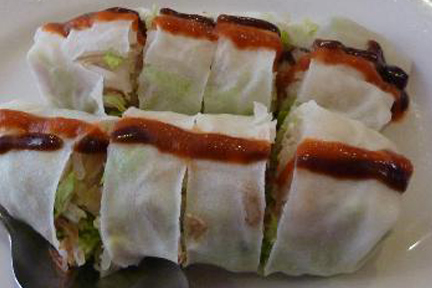Popiah is a Fujianese/Teochew-style fresh spring roll. Popiah is often eaten in the Fujian province of China (usually in Xiamen) and its neighbouring Chaoshan (and by the Teochew and Hoklo diaspora in various regions throughout Southeast Asia) and in Taiwan (due to the majority of Taiwanese being Hoklo), during the Qingming Festival. The origin of popiah dates back to the 17th century.
A popiah "skin" (薄餅皮) is a soft, thin paper-like crepe or pancake made from wheat flour. The method of producing the wrapper involves making an extremely wet and viscous dough. A ball of this dough is held to the right hand, then quickly "rubbed" (擦潤餅皮, Hokkien: chhat jūn-piáⁿ phê, literally "to rub a lumpia crepe") against a hot steel plate in a circular fashion, and lifted. Through this process, a very thin layer of the wet dough adheres to the plate and begins to cook. The upper surface of the crepe is then usually cleaned of excess pieces of dough using the dough ball through a dabbing process. When the dough has been cooked to completion, it is peeled off of the hot steel plate before being removed. The rubbing is typically done over two or three plates at once, which allows the baker to continuously produce crepes and gives the proper time for each crepe to be properly cooked.
It is eaten in accompaniment with a sweet sauce (often a bean sauce), a blended soy sauce or hoisin sauce or a shrimp paste sauce and optionally with hot chilli sauce before it is filled. The filling is mainly finely grated and steamed or stir-fried turnip, jicama (known locally as bangkuang), which has been cooked with a combination of other ingredients such as bean sprouts, French beans, and lettuce leaves, depending on the individual vendor, along with grated carrots, slices of Chinese sausage, thinly sliced fried tofu, chopped peanuts or peanut powder, fried shallots, and shredded omelette. Other common variations of popiah include pork (lightly seasoned and stir-fried), shrimp or crab meat. Seaweed is often included in the Xiamen versions. Some hawkers in Malaysia and Singapore, especially in non-halal settings, will add fried pork lard. As a fresh spring roll, the popiah skin itself is not fried.
It is eaten in accompaniment with a sweet sauce (often a bean sauce), a blended soy sauce or hoisin sauce or a shrimp paste sauce and optionally with hot chilli sauce before it is filled. The filling is mainly finely grated and steamed or stir-fried turnip, jicama (known locally as bangkuang), which has been cooked with a combination of other ingredients such as bean sprouts, French beans, and lettuce leaves, depending on the individual vendor, along with grated carrots, slices of Chinese sausage, thinly sliced fried tofu, chopped peanuts or peanut powder, fried shallots, and shredded omelette. Other common variations of popiah include pork (lightly seasoned and stir-fried), shrimp or crab meat. Seaweed is often included in the Xiamen versions. Some hawkers in Malaysia and Singapore, especially in non-halal settings, will add fried pork lard. As a fresh spring roll, the popiah skin itself is not fried.
In Malaysia and Singapore, popiah is part of Chinese cuisine of these two countries. However, in both countries, as well as in Brunei, popiah especially the fried variant is also popular as part of local street food.

- Ann Chin Popiah - Chinatown Complex Food Centre #02-112
- Ann Chin Popiah 安珍 - 530 Ang Mo Kio Ave 10
- 968 Popiah - 81 Whampoa Drive #01-893
- Old Longhouse Master of Popiah - Kim Keat Palm Market & Food Centre #01-03
- Jit It Tai Shan Popiah - 449 Clementi Ave 3 #01-211
- My Cozy Corner - Coronation Shopping Plaza #02-02
- Glory Catering - 139 East Coast Road
- Kway Guan Huat Joo Chiat Popiah - 95 Joo Chiat Road
- Mr Popiah - AMK Hub #03-12
- Good Chance Popiah Eating House - 149 Silat Avenue #01-58
- Ping Kee Popiah - Sembawang Hill Food Centre #01-32
